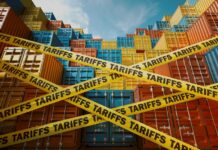When it comes to the economy, Donald Trump was born on third base and claims he hit a triple. But now, he seems determined to be thrown out before reaching home.
His latest move is threatening to impose tariffs on all goods coming from Mexico, starting at 5% and rising to 25% in October. He made the announcement Thursday, even as he is asking Congress to approve a new trade deal to keep virtually all tariffs on goods from Mexico at … zero.
It’s a contradiction on the order of pressing one foot on the accelerator while using the other to stomp on the brakes. “Why even have a trade agreement if it means nothing?” former Mexican diplomat Jorge Guajardo asked a reporter for The Washington Post.
That’s just one of the questions that will occur to people on Capitol Hill. Others include: Why did the president go to the trouble of negotiating a new free trade deal to replace NAFTA if he has no intention of actually practicing free trade? Why would members of Congress bother voting on an accord that he would feel entitled to override?
This step comes on top of the 25% tariffs the president has already imposed on Chinese goods, which, contrary to his habitual lies, will be paid by Americans. A new report from the Federal Reserve Bank of New York estimates that Trump’s tax on Chinese imports will cost the average U.S. household $831 a year.
That’s not counting the consequences of his taxes on imported steel and aluminum, washing machines and solar panels. It’s also not counting the burden on American exporters from retaliatory tariffs imposed by Beijing. Pork producers and soybean growers saw their sales to China plummet last year, and the effect is likely to be even more painful this year.
The administration has admitted as much, promising to compensate farmers with $16 billion in federal aid, on top of the $12 billion it handed out in 2018. The help, farmers say, will fall short of making them whole. It will, however, add to the loss borne by taxpayers, who will suffer twice — once in financing the government payments and again when they go shopping.
The U.S. auto industry stands to suffer because the new tariffs on Mexico will tie knots in their internal supply chains, which involve making and assembling components in both countries. “This would cripple the auto industry,” Torsten Slok, chief economist for Deutsche Bank Securities, told Yahoo Finance. “It would bring car production to a halt pretty quickly.”
All these measures could hardly be better engineered to squander the good times that Trump inherited and has so far maintained. Presidents typically have far less impact on the real economy, for good or ill, than the public assumes. But Trump has been doing his best to prove otherwise.
Having arrived in the White House during an expansion that was nearly 8 years old, Trump has been happy to take credit for something that began under Barack Obama. In the first quarter of 2019, real GDP grew at a strong 3.1% clip, which Trump and his allies in Congress celebrated as proof of his business savvy.
It wasn’t. In fact, the economy exceeded that pace as recently as the second quarter of 2015 — when Republicans were accusing Obama of stifling growth. The Dow Jones Industrial Average is up some 5,000 points under Trump, on top of the 12,000 it gained under his predecessor.
Unemployment fell from 10% to 4.7% during the Obama years, and it has dropped to 3.6% under Trump.
The administration and its allies in Congress argue that the recent solid growth is a direct result of the mammoth tax cut enacted in 2017. But a new report by the nonpartisan Congressional Research Service concluded it had “a relatively small (if any) first-year effect on the economy” and that growth has been “in line with the trend in growth” since 2013. Oh, and the tax cut didn’t come close to paying for itself.
On economic matters, Trump is an impetuous meddler who brings to mind what Theodore Roosevelt’s daughter Alice Roosevelt Longworth said: “My father always wanted to be the corpse at every funeral, the bride at every wedding and the baby at every christening.” But Trump’s policies are likely to confirm that, often, the best policy is to leave well enough alone.





























